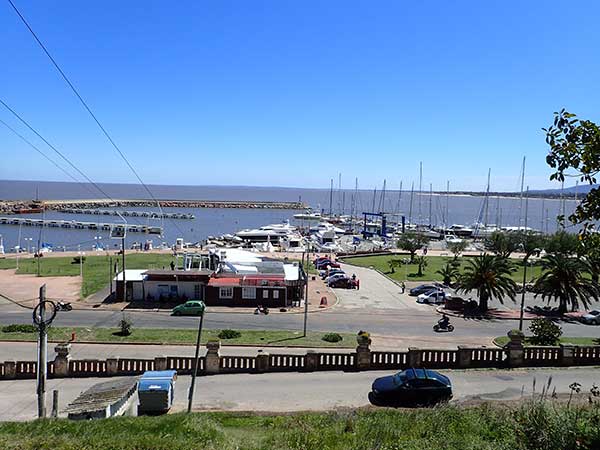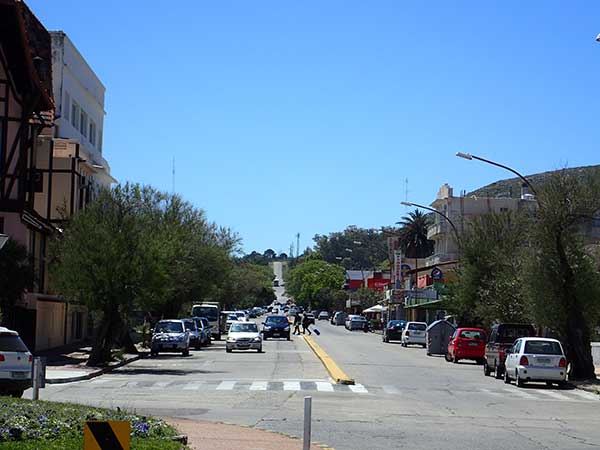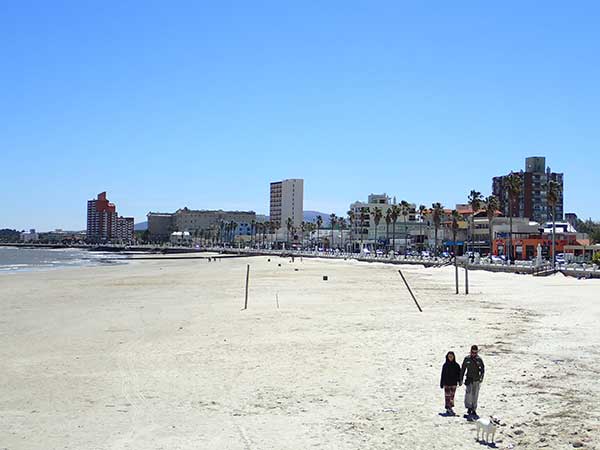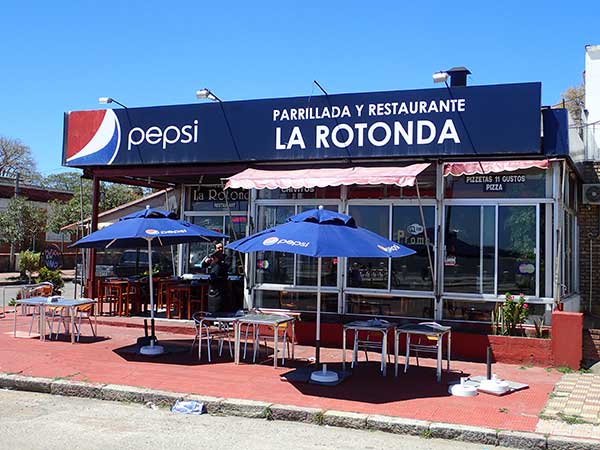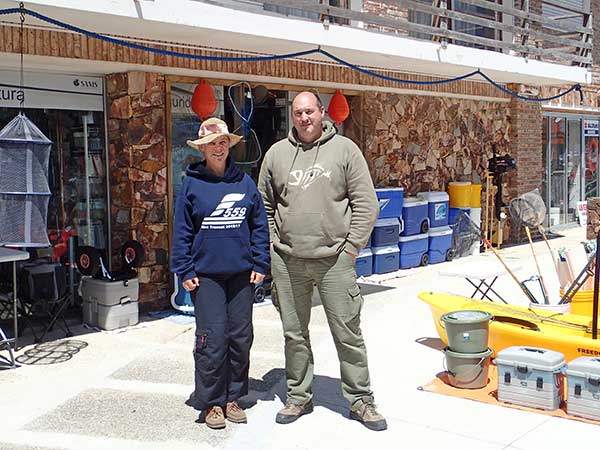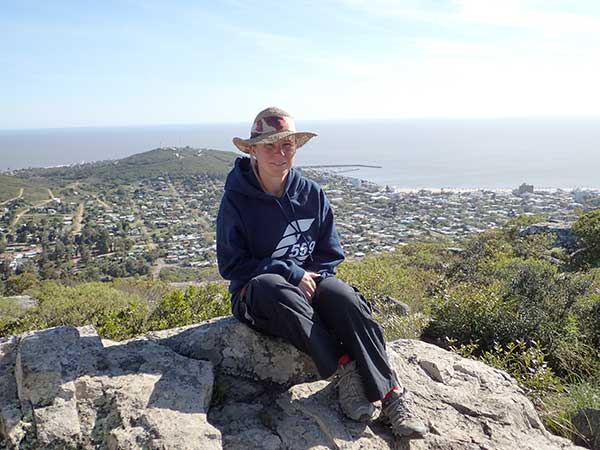What is the difference between a propeller and a bucket?

Caramor - sailing around the world
Franco Ferrero / Kath Mcnulty
Tue 20 Oct 2015 02:41
No difference. According to various articles about boat propellers, the drag caused by the propeller when under sail is the equivalent to towing a bucket.
Maybe, but when it comes to motoring into a 50 knot headwind to get into a sheltered anchorage, I know which one I would prefer to have, and its not the bucket.
You may be wondering why I am rabbeting on about propellers. We aren't exactly up the proverbial Shit Creek without a paddle but we are certainly on the hard in Piriapolis without a propeller.
We did have one when we arrived. However, close inspection suggested all was not right, the edges were badly damaged, surprising as it was brand new when we left Holyhead. Diego, the local mechanic who has made our windturbine pole had a look and thought he could fix it. He said it looked like galvanic corrosion.*
When Diego tried to weld metal onto our propeller to repair it, he found that the whole structure was honeycombed, beyond repair.
We were astounded. Our sacrificial anode** was working so why hadn't it protected our propeller? The problem was soon revealed, the copper strap which is supposed to connect the prop to the anode had not been replaced after the engine was changed. The mechanic and his apprentice had forgotten, and we didn't know any better.
Franco fitting a paper propeller (at least this one won't suffer from galvanic corrosion!)
Mistakes happen and even good mechanics can have bad hair days. Franco told me he was 'more than slightly annoyed', an understatement if ever there was one, as he prowled up and down the ladder, snarling.
We need a new propeller. The closest factory is in Buenos Aires but it may as well be on planet Mars as far as importing one goes.
A few months ago, after meeting Windward in Buzios, we had looked into ordering a feathering propeller as it is supposed to reduce the drag when sailing. The Brunton was too big to fit Caramor but alarm bells had started ringing when the manufacturer expressed surprise that our gearbox ratio was 2:1 rather than 2.6:1.
While looking for props on the internet, we came across Darglow who manufacture feathering props in the UK and have fitted their Featherstream model to several Rustler 36s. Their technical manager is categoric: our gear box ratio is too small, we are over-propped and this is putting unnecessary pressure on the engine without giving us thrust or speed.
In one of our early posts 'Sunny day in Holyhead, 12 May 2014' we described having to be hauled out again in Holyhead to have a new propeller fitted. The problem was never the propeller, the problem was the gearbox. Now we know, after spending the past three days reading everything we can get our hands on about engines, gearboxes, propeller diameter and pitch. Even with the new propeller the performance had been disappointing, but we were told it was as good as it would get.
Franco is distinctly irritated, at least two steps higher on the red alert spectrum than 'more than slightly annoyed'.
We need a new gearbox. The gearbox manufacturer has a distributor in Buenos Aires. Perfect. Unfortunately they don't carry stock and would need to order one from the factory in Italy. Six weeks and counting ...
Fortunately Beta Marine, the company that supplied the engine have the 2.6:1 gearbox in stock.
As my mother always used to say: "There is no point crying over spilt milk." This time we will get it right. The whole point of hauling out in Piriapolis is to make sure everything is as good as we can get it, down in the far south we will need all our gear to be working well.
Although not on our original schedule, Uruguay is very lovely and 'muy tranquilo'. We have found an ice-cream parlour and have made a few friends. What else do you need?
Ah yes, a boom. Caramor's has had a face lift in Diego's workshop.
Around Piriapolis on a sunny day
Port of Piriapolis (currently being renovated). Caramor is one of the masts on the right.
Main Street during rush hour!
The spruced-up sea front
Piriapolis beach
The venue for great live music every week-end
Kath with Alejandro outside his shop 'South Atlantic Marine Services'
Tom's van. It took him five years to sail here from the UK and he has decided to go no further.
Typical car and house
Mr Piria's folly - the bull fountain
Kath at the top of the Cerro del Toro (389m), the fourth highest "mountain" in Uruguay. The tallest is 513m.
Techie stuff
*The principle of galvanic corrosion (http://www.yachtinglife.net/new%20index/frames3/electrol_frame.htm)
The principle of electrolysis is based on the fact that when a metal is put into water it will create a non neutral voltage. On the surface a very small quantity of positive charged metal ions will break out leaving the negative charge in the form of electrodes behind in the metal. The metal will be negatively charged. As long as this metal is not connected to another object with a different charge, nothing will happen and a balance will have been reached.
The problem starts because all existing metals have a different charge when put underwater. Some positive, some negative. The absolute charge varies and increases when the temperature rises, the amount of salt in the water is higher and if more oxygen is present in the water. Only when the two different metals are electrically connected, electrolysis can start. One metal (the one with the most negative charge) will act as anode and sacrifice itself. The other metal with act as cathode. As the anode is electrically connected to the positively charged cathode, it can't reach it's natural negatively charged balance as described above. But it will constantly try to reach it. To get a more negative charge, the metal will split constantly into positively charged metal ions breaking out of the surface and leaving behind the negatively charged electrons. The electrons will be transported through the wire connection the two metals to the more positive charged cathode, and the whole process will start over again. It will only end when the complete anode is dissolved.
** Caramor has a sacrificial anode, a lump of 'soft' metal bolted to her hull. All metal parts that are under the water are connected to this anode. The idea is that the soft metal will dissolve, "protecting" all the other metal parts. (With the exception of all skin fittings, which are not connected, as per the recommendation in the Marine Accident Investigation Branch report (https://www.gov.uk/maib-reports/flooding-of-charter-fishing-vessel-random-harvest-off-brighton-england)


